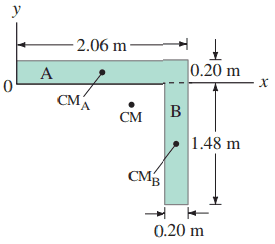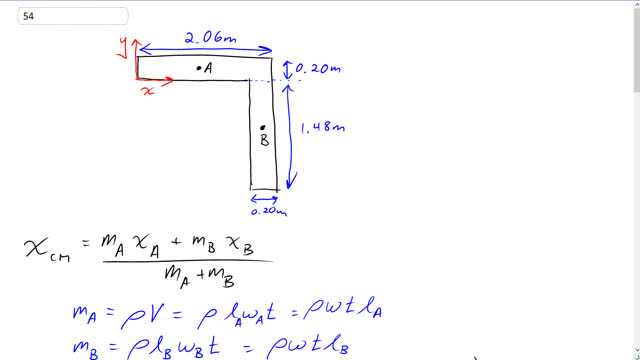
Determine the CM of the uniform thin L-shaped construction brace shown in Fig. 7–40.


In order to watch this solution you need to have a subscription.
This is Giancoli Answers with Mr. Dychko. To find the center of mass of this bracket, we'll consider the x-direction first; we'll find the distance of the center of mass of part A which is this thing here, this part of the bracket including this section here. We'll take the mass of that part A times by the distance from the center of mass of part A to the origin in the x-direction. So the whole length of part A is 2.06 and we'll call that l A and so we'll have l A divided by 2 is gonna be x A, the distance from the center of mass of part A to the origin in the x-direction, okay. So we'll find the mass of part A then as well times the density by the volume of this little section and the volume is gonna be its length l A times its width of 0.2 meters times its thickness and we don't know the thickness— we'll just put in t. And so we have ρwtl A where I have removed the subscript for the width since the width of part A and the width of part B are the same they are both 0.2 so there's no need to distinguish them with subscripts. So we have ρwtl A for the mass of part A. For part B, we have ρl B times the width times the thickness where l B is is 1.48 meters and we'll take the distance from the center of mass of part B to the origin in the x-direction that's what's gonna be x B and x B is gonna be the length of part A minus this little bit from the edge here to the center of part B that is the horizontal center I should say so this little bit here is the width divided by 2 so it's 0.2 over 2 or 0.1 meters in other words. So we have a w over 2 here and there we go. So I have substituted for each of the terms in the center of mass x-coordinate with a mass of A, the position of the center of mass of A in the x-direction plus the mass of B and x B divided by the total mass. And ρwt is a common factor among all terms and so it cancels everywhere and we are left with l A times l A so it's l A squared over 2 plus l A times l B minus l B times w over 2 all over l A plus l B. And then because it's confusing to have fractions of the fractions, let's multiply the top and bottom by 2 so we have 2 times l A plus l B at the bottom and at the top, we have l A squared plus 2 times l Al B minus l B times w and then plug in some numbers and we get our answer, at least part of it anyway. So we get 2.06 meters squared plus 2 times 2.06 meters—length of part A— times 1.48 meters—length of part B— minus—length of part B—1.48 meters times 0.20 meters—width of part B— divided by 2 times the lengths of each and then that gives us 1.42 meters and that's from the left. And then we do the same idea for the y-direction where the y-position of the center of mass of part A is the width of part A divided by 2 so this is w over 2; that's how high above the x-axis or in other words, that's the y-coordinate of the center of mass of part A and multiplying that by mass of part A. And then plus the mass of part B times the y-coordinate of the center of mass of part B which is part B's length over 2 so this is l B right here or sorry, this is y B this is the y-coordinate of the center of mass of part B and it's l B over 2 and it's negative because it's below the x-axis and so that's why I put a negative sign there and divide by the total mass. And again ρwt cancels everywhere and we are left with l Aw over 2 minus l B times l B so that's minus l B squared over 2, multiply top and bottom by 2 and you get l Aw minus l B squared over 2 times l A plus l B; that's 2.06 meters times 0.20 meters minus 1.48 meters squared divided by 2 times the sum of the lengths and that gives negative 0.25 meters. So the center of mass of the bracket is 1.42 meters from the left so that looks like it's approximately, well, this is 2.06 and so maybe 1.42 is about here say and then 0.25 meters below the x-axis so that's approximately the center of mass right there.